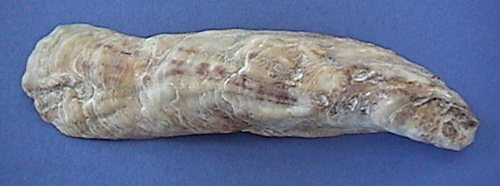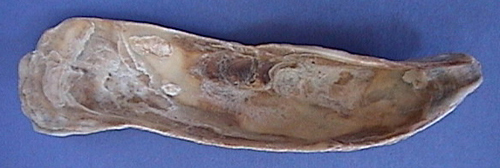|
Eastern Oyster (Crassostrea virginica)
|
|
This very common mollusk varies in shape and color, but is usually long and narrow, ranging up to ten inches in length. The shell is thick and sturdy with irregular ridges on the outside while the inside is smooth and often purple with one dark purple adductor muscle scar. Oysters thrive in water of low to medium salinity and depths from low tide to 40 feet. Because they have no foot for moving, oysters can be found permanently cemented to hard objects often in clusters or oyster beds, where they attach to each other. Although oysters do not have siphons, they filter plankton by fanning water over internal gills. The ability to filter up to seven gallons of water a day make oysters an important component of any aquatic ecosystem. By filter feeding, oysters accumulate bacteria and can pass diseases to humans when eaten. If siltation becomes too great from activities such as dredging, oysters can be smothered and die. Oysters can change sex repeatedly during their lives, but large oysters are generally functional females, averaging a release of about 100 million eggs during one spawning, which takes place two to three times a season. Less than ten of these eggs will reach maturity. Fertilized eggs hatch into tiny animals called spat that become free-floating zooplankton, which is a food source for many fish and other species. These larval oysters must find a hard surface to settle on, a large number attaching themselves to other oysters, in order to survive. In three to five years, oysters can reach three to four inches in length. Oysters are preyed upon by sea stars, oyster drills, moon snails, rays, oystercatchers, and man, and have been an important food source for thousands of years, resulting in oyster farming in artificial beds for easier access and control. |

